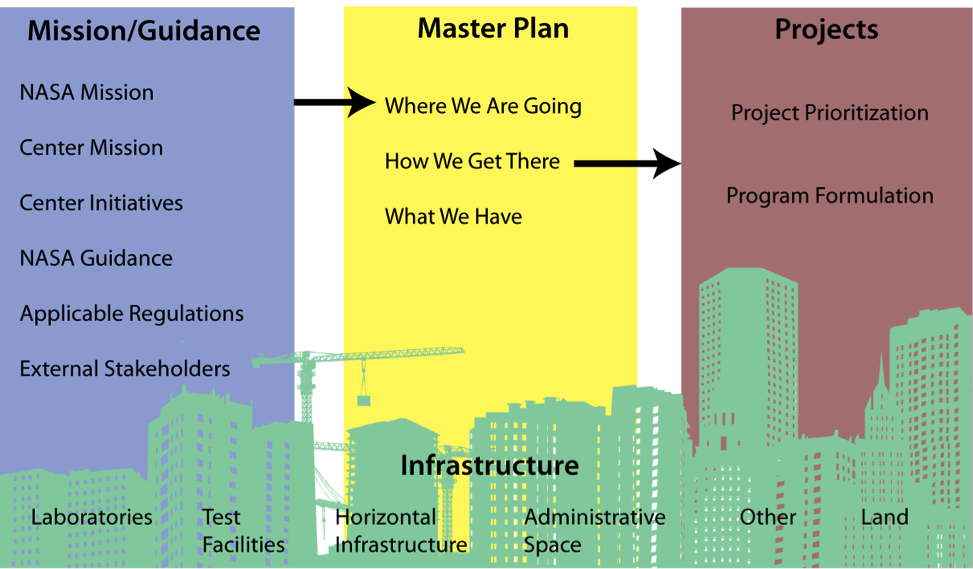
Procedural
Requirements
Effective Date: February 13, 2013
Expiration Date: March 31, 2025

|
NASA Procedural Requirements |
NPR 8810.1A Effective Date: February 13, 2013 Expiration Date: March 31, 2025 |
| | TOC | Preface | Chapter1 | Chapter2 | Chapter3 | Chapter4 | AppendixA | AppendixB | ALL | |
3.1.1 Those directly engaging in the CMP (herein referred to as "master planners") shall develop, record, and communicate a comprehensive plan according to the requirements of this chapter.
3.1.2 Master planners shall develop, record, and convey CMPs, where:
a. Development is inclusive, thorough, analytical, equitable, traceable, and sustainable.
b. Documentation is comprehensive, traceable, predictive, and compliant with applicable guidance.
c. The plan is conveyed in a clear, accessible, accountable, and traceable fashion.
3.2.1 As illustrated in Figure 3-1, master planners shall integrate a comprehensive facility strategic process that interrelates many separate objectives, the master plan itself, and implementation projects with a Center's real property assets. In the figure, the "Mission and Guidance" element describes the vision and requirements that are defined in the plan "Where we are going." The infrastructure element at the bottom of the diagram represents the Center's real property assets and informs the master plan section "What we have." Having defined the desired and current states, the master planner performs a gap analysis and captures the result as "How we get there." Thus the master plan can inform the development and prioritization of implementation projects, with master plan strategies and objectives as the criteria against which facility projects are prioritized and facility programs are formulated. Implementing these projects, in turn, changes the Infrastructure element. As this will change the gap analysis over time, the planning process is iterative and must be revalidated or revised.

Figure 3-1 The Center Master Planning Process
3.3.1 Master planners shall:
a. Encourage all identified stakeholders to participate in plan development, including as a minimum representatives of mission programs, Center and Headquarters institutional stewards, onsite staff, onsite tenant organizations, and the external community.
b. Take appropriate steps to understand and document current conditions (capabilities, opportunities, constraints) and current and projected requirements.
c. Use an analytical process to identify gaps between current conditions and requirements and develop an appropriate range of alternatives to address those gaps.
d. Strive for equity by defining evaluation criteria that span the full range of stakeholder interests and using these criteria in a consistent fashion to evaluate and select among alternatives.
e. Document the development process sufficiently to demonstrate that resulting proposals are responsible choices among alternatives in accordance with Agency risk management practices.
f. Strive to address plan requirements in a sustainable fashion (using resources responsibly and maintaining a resilient, productive, safe, secure, and healthy work environment).
g. Ensure that realistic costs of projected plan investments fit within the funding profile direction from TCRPMD.
3.4.1 Master planners shall ensure the CMP:
a. Addresses all real property assets, including land and improvements at all sites the Center owns or manages, whether constructed or occupied by NASA or others and whether stewarded by a program or institution.
b. Addresses all identified requirements, whether current or projected, qualitative or quantitative, in ways that make the requirements and the evaluation criteria transparent.
c. Incorporates sufficient flexibility to address current conditions, planned future needs, and unplanned but predictable changes (e.g., funding adjustments or changes in resources or schedule) to ensure that proposals remain responsive across a range of future circumstances.
d. Meets statutes, regulations, and policies including, but not limited to, NPR 8580.1, Implementing the National Environmental Policy Act and Executive Order 12114; and NPR 8590.1, ECR Program.
e. Aligns with the Center's National Historic Preservation Act Section 110 and 106 planning processes/documents, especially regarding reutilization and demolition of eligible facilities.
3.5.1 Master planners shall ensure the CMP has the following characteristics:
a. Conveys Center plans in a clear and logical fashion, making Center intentions, evaluation criteria, and proposals evident to the full range of stakeholders.
b. Makes appropriate information available to stakeholders with minimum difficulty.
c. Conveys Center plans with sufficient specificity to ensure that they are readily understood and their implementation can be measured over time.
d. Records current circumstances and the program of needs clearly and fully enough that plan implementation can be traced against baseline and provides accountability.
| TOC | Preface | Chapter1 | Chapter2 | Chapter3 | Chapter4 | AppendixA | AppendixB | ALL | |
| | NODIS Library | Program Management(8000s) | Search | |
This document does not bind the public, except as authorized by law or as incorporated into a contract. This document is uncontrolled when printed. Check the NASA Online Directives Information System (NODIS) Library to verify that this is the correct version before use: https://nodis3.gsfc.nasa.gov.